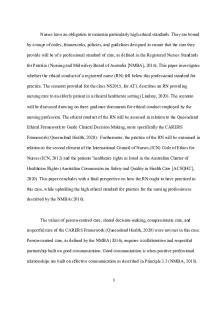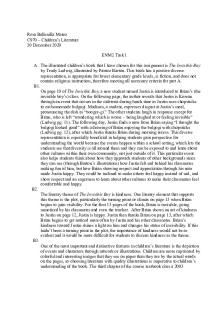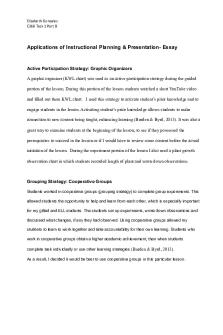BSBPMG522 Assessment Task 1 PDF

| Title | BSBPMG522 Assessment Task 1 |
|---|---|
| Author | Minh Thanh Nguyen |
| Course | Undertake Project Work |
| Institution | Cambridge International College |
| Pages | 9 |
| File Size | 319.5 KB |
| File Type | |
| Total Downloads | 58 |
| Total Views | 197 |
Summary
BSBPMG522 Assessment Task 1...
Description
BSBPMG522 Undertake project work
Student Assessment Tasks
Assessment Task 1 Cover Sheet Student Declaration To be filled out and submitted with assessment responses I declare that this task is all my own work and I have not cheated or plagiarised the work or colluded with any other student(s). I understand that if I am found to have plagiarised, cheated or colluded, action will be taken against me according to the process explained to me. I have correctly referenced all resources and reference texts throughout these assessment tasks. Student name
Minh Thanh Nguyen
Student ID number
201712842
Student signature
Date
22-01-2020
Assessor declaration I hereby certify that this student has been assessed by me and that the assessment has been carried out according to the required assessment procedures. Assessor name Assessor signature Date Assessment outcome
S
NS
DNS
Resubmission
Y
N
Feedback
Student result response My performance in this assessment task has been discussed and explained to me. I would like to appeal this assessment decision. © J&S Learningwork 2018
Strathfield College RTO: 91223 CRICOS Provider Code: 02736K
Page 1
BSBPMG522 Undertake project work
Student Assessment Tasks
Student signature
Date
22-01-2020
A copy of this page must be supplied to the office and kept in the student’s file with the evidence.
© J&S Learningwork 2018
Strathfield College RTO: 91223 CRICOS Provider Code: 02736K
Page 2
BSBPMG522 Undertake project work
Student Assessment Tasks
Assessment Task 1: Written Questions Task summary This is an open book test, to be completed in the classroom. A time limit of 2 hours to answer the questions is provided. You need to answer all of the written questions correctly. Required
Access to textbooks/other learning materials
Timing Your assessor will advise you of the date and time of this assessment. Submit
Answers to all questions
Assessment criteria All questions must be answered correctly in order for you to be assessed as having completed the task satisfactorily.
Re-submission opportunities You will be provided feedback on their performance by the Assessor. The feedback will indicate if you have satisfactorily addressed the requirements of each part of this task. If any parts of the task are not satisfactorily completed, the assessor will explain why, and provide you written feedback along with guidance on what you must undertake to demonstrate satisfactory performance. Re-assessment attempt(s) will be arranged at a later time and date. You have the right to appeal the outcome of assessment decisions if you feel that you have been dealt with unfairly or have other appropriate grounds for an appeal. You are encouraged to consult with the assessor prior to attempting this task if you do not understand any part of this task or if you have any learning issues or needs that may hinder you when attempting any part of the assessment.
Written answer question guidance The following written questions use a range of “instructional words” such as “identify” or “explain”, which tell you how you should answer the question. Use the definitions below to assist you to provide the type of response expected. © J&S Learningwork 2018
Strathfield College RTO: 91223 CRICOS Provider Code: 02736K
Page 3
BSBPMG522 Undertake project work
Student Assessment Tasks
Note that the following guidance is the minimum level of response required. Analyse – when a question asks you to analyse something, you should do so in in detail, and identify important points and key features. Generally, you are expected to write a response one or two paragraphs long. Compare – when a question asks you to compare something, you will need to show how two or more things are similar, ensuring that you also indicate the relevance of the consequences. Generally, you are expected to write a response one or two paragraphs long. Contrast – when a question asks you to contrast something, you will need to show how two or more things are different, ensuring you indicate the relevance or the consequences. Generally, you are expected to write a response one or two paragraphs long. Discuss – when a question asks you to discuss something, you are required to point out important issues or features and express some form of critical judgement. Generally, you are expected to write a response one or two paragraphs long. Describe – when a question asks you to describe something, you should state the most noticeable qualities or features. Generally, you are expected to write a response two or three sentences long. Evaluate – when a question asks you to evaluate something, you should do so putting forward arguments for and against something. Generally, you are expected to write a response one or two paragraphs long. Examine – when a question asks you to examine something, this is similar to “analyse”, where you should provide a detailed response with key points and features and provide critical analysis. Generally, you are expected to write a response one or two paragraphs long. Explain – when a question asks you to explain something, you should make clear how or why something happened or the way it is. Generally, you are expected to write a response two or three sentences long. Identify – when a question asks you to identify something, this means that you are asked to briefly describe the required information. Generally, you are expected to write a response two or three sentences long. List – when a question asks you to list something, this means that you are asked to briefly state information in a list format. Outline – when a question asks you to outline something, this means giving only the main points, Generally, you are expected to write a response a few sentences long. © J&S Learningwork 2018
Strathfield College RTO: 91223 CRICOS Provider Code: 02736K
Page 4
BSBPMG522 Undertake project work
Student Assessment Tasks
Summarise – when a question asks you to summarise something, this means (like “outline”) only giving the main points. Generally, you are expected to write a response a few sentences long.
© J&S Learningwork 2018
Strathfield College RTO: 91223 CRICOS Provider Code: 02736K
Page 5
BSBPMG522 Undertake project work
Student Assessment Tasks
Assessment Task 1 Instructions Provide answers to all of the questions below: 1.
2.
3.
4.
5.
List three project management tools and explain their use in project management. Cost schedule control system determines when work elements (activities) are to be completed, milestones achieved, and when the project should be completed. The budget determines how much each work element should cost, the cost of each level of the work breakdown schedule (WBS), and how much the total project should cost. Life cycle cost analysis determines the cost associated with the project from the beginning of the project to the end of its useful life and beyond. It includes the cost of acquiring the project, operating it, and disposing of it at the end of its useful life. Spreadsheets are a useful visual tool to track each task's progress against the original plan. The spreadsheet should include all tasks, their status, the owner of the task, the percent complete and the planned duration versus actual duration. Explain the use of a GANTT chart in project management. Gantt chart is useful for planning and scheduling projects. It helps to assess how long a project should take, determine the resources needed, and plan the order in which you’ll complete tasks. It’s also helpful for managing the dependencies between tasks. Explain the use of a PERT chart in project management. A PERT chart is a project management tool used to schedule, organize and coordinate tasks within a project. It provides a graphical representation of a project's timeline that allows project managers to break down each individual task in the project for analysis. Explain the use of a work breakdown structure in project management. Work breakdown structure offers a visual way to detail the deliverables within a project. It does so by presenting key milestones within a hierarchy that simplifies large projects into smaller, more manageable groups. Explain the use management.
of
the
critical
path
method
in project
Critical path method (CPM) is a resource-utilization algorithm for scheduling a set of project activities. This method outlines a list of all tasks required to complete a project, the dependencies between the tasks and the estimate of time that each activity will take to complete.
© J&S Learningwork 2018
Strathfield College RTO: 91223 CRICOS Provider Code: 02736K
Page 6
BSBPMG522 Undertake project work
6.
7.
8.
Student Assessment Tasks
Outline three types of documents and sources of information that are used to define the parameters of a project. Project Schedule uses project software to manage their projects' schedules, resources, dependencies, and project costs i.e Excel spreadsheet. Risk Management is used for the purpose of capturing risks by group and category, and it allows you to rank or prioritize your risks. Risks could convert to issues. Project Budget is used to track all costs associated within the project that includes resources, hardware, software, and vendors. Explain the importance of planning for risks in a project and list three processes that can be used to identify risks as part of a risk assessment process for a project. Risk management is an important part of project management because achieving a project's goals depends on planning, preparation, results and evaluation that contribute to the success of the project. Risk management is an action plan that consists of various steps which are done to ensure the removal of risk. By planning for unexpected events, you can be ready to respond if problems arise. 3 ways to identify risks: o Cause and Effect Diagrams are used to help identify causes that give rise to risks and if we address the causes, we can reduce or eliminate the risks. o SWOT analysis is a tool for systematic risk identification consisting of four elements: strengths, weaknesses, opportunities, and threats. o A Risk Register is a living document that is updated regularly throughout the life cycle of the project. It becomes a part of project documents and is included in the historical records that are used for future projects. The risk register includes: List of Risks List of Potential Responses Root Causes of Risks Updated Risk Categories Explain the importance of a risk management identifying and managing risks for a project.
plan
in
Risk management allows managers to identify possible risks, problems or disasters before they happen. This allows business owners to set up procedures to avoid the risk, minimize its impact, or at the very least help cope with its impact.
© J&S Learningwork 2018
Strathfield College RTO: 91223 CRICOS Provider Code: 02736K
Page 7
BSBPMG522 Undertake project work
Risk management plan allow managers to analyse risks using risk categorise to identify the severity/likelihood of risks therefore, reduce the probability of occurrence of risks while executing a project.
9.
Explain risk avoidance in project management. Risk avoidance is the elimination of hazards, activities and exposures that can negatively affect an organisation’s project. Its strategy is designed to deflect as many threats as possible in order to avoid the costly and disruptive consequences of a damaging event.
10.
Explain the use management.
of
risk
mitigation
strategies
in
project
Risk mitigation strategies can be defined as a measure or set of measures taken by a project manager to reduce or eliminate the risks associated with a project. Risks can be of various types such as technical risks, monetary risks and scheduling-based risks. The project manager takes complete authority of reducing the probability of occurrence of risks while executing a project. Take early action ASAP to reduce impact of any possible risks may arise
11.
Student Assessment Tasks
Explain the concept of risk acceptance in project management.
Risk acceptance is the act of accepting the identified risk and not taking any other action in order to reduce the risk because the impact and possible consequences is acceptable that’s why we choose to simply risk it. We choose the strategy of risk acceptance when it turns out to be the most economical option to do nothing about it. That is to say that the risk is either so small or so unlikely that we decide to cope with the consequences in case the incident happens.
© J&S Learningwork 2018
Strathfield College RTO: 91223 CRICOS Provider Code: 02736K
Page 8
BSBPMG522 Undertake project work
Student Assessment Tasks
Assessment Task 1 Checklist Student’s name: Did the student provide a sufficient and clear answer that addresses the suggested answer for the following?
Satisfactory performance Yes No
Comments
Question 1 Question 2 Question 3 Question 4 Question 5 Question 6 Question 7 Question 8 Question 9 Question 10 Question 11 Task Outcome:
Satisfactory
Not Satisfactory
Assessor signature Assessor name Date
© J&S Learningwork 2018
Strathfield College RTO: 91223 CRICOS Provider Code: 02736K
Page 9...
Similar Free PDFs

BSBPMG522 Assessment Task 1
- 9 Pages

Assessment TASK 1 – Scenario
- 5 Pages

Assessment Task 1
- 2 Pages

Reflection Assessment Task 1
- 4 Pages

NS2015 Assessment Task 1
- 7 Pages

Assessment Task
- 3 Pages

Bsbcrt 412 - Assessment Task 1
- 5 Pages

Bsbcmm 511 - Assessment Task 1
- 14 Pages

Assessment Task 3
- 1 Pages

Remedies - Assessment Task
- 5 Pages
Popular Institutions
- Tinajero National High School - Annex
- Politeknik Caltex Riau
- Yokohama City University
- SGT University
- University of Al-Qadisiyah
- Divine Word College of Vigan
- Techniek College Rotterdam
- Universidade de Santiago
- Universiti Teknologi MARA Cawangan Johor Kampus Pasir Gudang
- Poltekkes Kemenkes Yogyakarta
- Baguio City National High School
- Colegio san marcos
- preparatoria uno
- Centro de Bachillerato Tecnológico Industrial y de Servicios No. 107
- Dalian Maritime University
- Quang Trung Secondary School
- Colegio Tecnológico en Informática
- Corporación Regional de Educación Superior
- Grupo CEDVA
- Dar Al Uloom University
- Centro de Estudios Preuniversitarios de la Universidad Nacional de Ingeniería
- 上智大学
- Aakash International School, Nuna Majara
- San Felipe Neri Catholic School
- Kang Chiao International School - New Taipei City
- Misamis Occidental National High School
- Institución Educativa Escuela Normal Juan Ladrilleros
- Kolehiyo ng Pantukan
- Batanes State College
- Instituto Continental
- Sekolah Menengah Kejuruan Kesehatan Kaltara (Tarakan)
- Colegio de La Inmaculada Concepcion - Cebu





